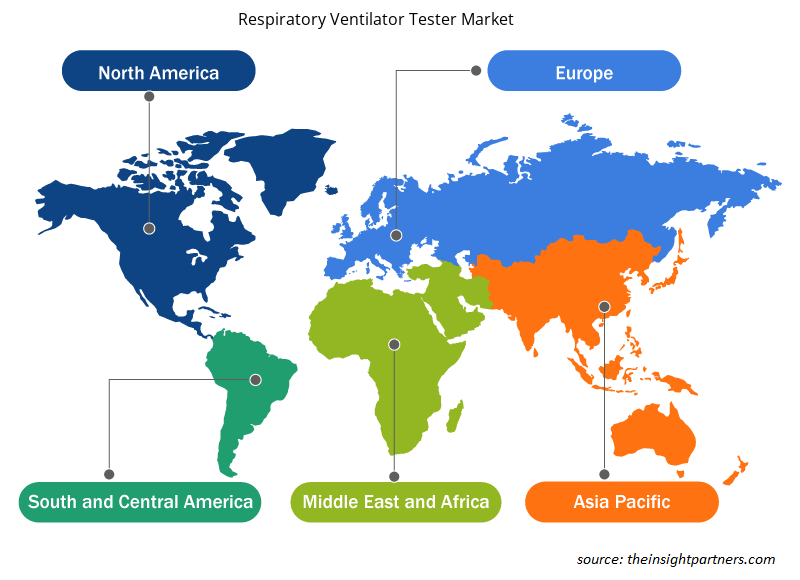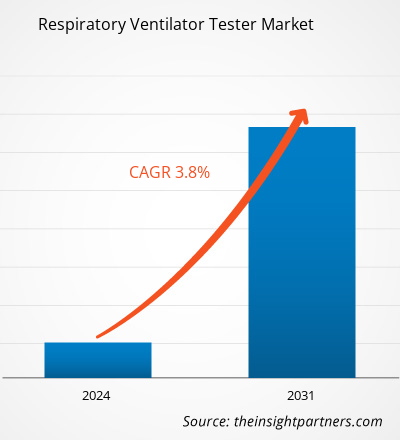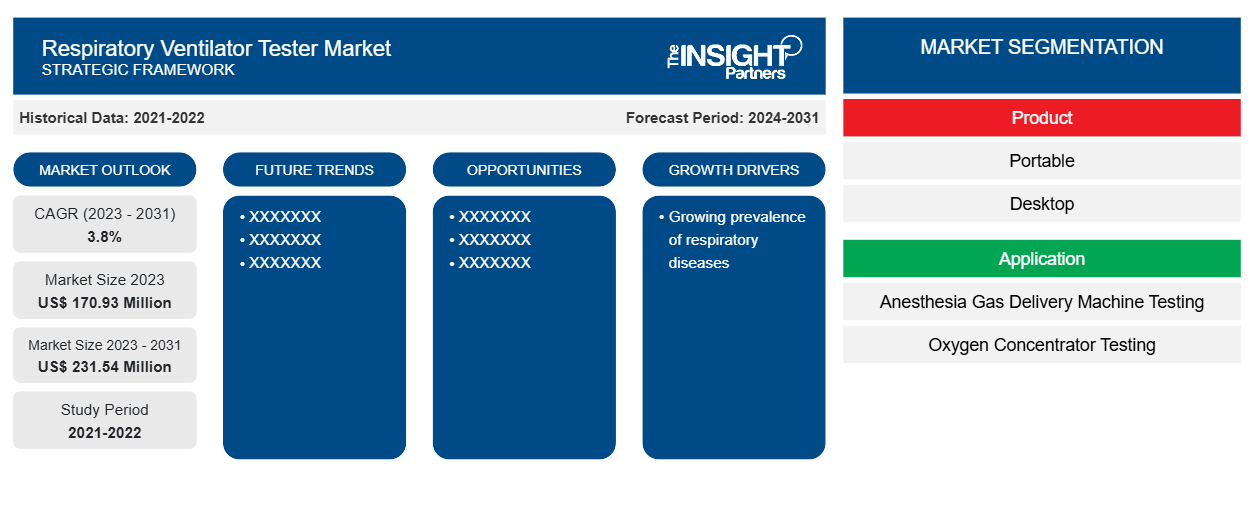Der Markt für Beatmungstester soll von 170,93 Millionen US-Dollar im Jahr 2023 auf 231,54 Millionen US-Dollar im Jahr 2031 anwachsen. Der Markt soll im Zeitraum 2023–2031 eine durchschnittliche jährliche Wachstumsrate von 3,8 % verzeichnen. Die zunehmende Verbreitung von Atemwegserkrankungen, die wachsende Nachfrage nach Beatmungstestern in Krankenhäusern und technologische Fortschritte bei Beatmungstestern zur Messung der Vitalparameter werden wahrscheinlich weiterhin die wichtigsten Trends auf dem Markt für Beatmungstester bleiben.
Marktanalyse für Beatmungstester
Die zunehmende Belastung durch Atemwegserkrankungen und die zunehmend alternde Bevölkerung, die anfällig für verschiedene Atemwegserkrankungen ist, steigern das Marktwachstum. Laut den im Dezember 2023 in einem Artikel von Jama Network Open veröffentlichten Daten wurde beispielsweise die COPD-Prävalenz im Jahr 2020 bei Männern und Frauen auf 10,6 % geschätzt, was etwa 480 Millionen Fällen entspricht. Bis 2050 werden die COPD-Fälle voraussichtlich um 112 Millionen auf insgesamt 592 Millionen ansteigen, insbesondere bei Frauen und in Regionen mit niedrigem bis mittlerem Einkommen. Daher wird erwartet, dass die enorme Belastung durch COPD, eine der wichtigsten Atemwegserkrankungen, die Gesamtnachfrage nach ihrer Behandlung erhöht und Beatmungstester erfordert, wodurch der Markt für Beatmungstester im Prognosezeitraum angekurbelt wird.
Marktübersicht für Beatmungstester
Nordamerika ist der größte Markt für das Wachstum des Marktes für Beatmungstester, wobei die USA den größten Marktanteil halten, gefolgt von Kanada. Faktoren wie die zunehmende Verbreitung von Atemwegserkrankungen, technologische Fortschritte in der Medizingeräteindustrie und die zunehmende Alterung der Bevölkerung, die anfällig für verschiedene Atemwegserkrankungen ist, werden den gesamten nordamerikanischen Markt für Beatmungstester voraussichtlich weiter vorantreiben. Laut dem im August 2023 in Aging and Disease veröffentlichten Artikel waren beispielsweise Atemwegsinfektionen ein erhebliches Gesundheitsproblem für die alternde Bevölkerung, insbesondere während der COVID-19-Pandemie im Jahr 2020. Die erhöhten Mortalitäts- und Morbiditätsraten wurden vor allem bei der älteren Bevölkerung über 65 beobachtet. Der normale Alterungsprozess der Lunge der alternden Bevölkerung erhöht die Anfälligkeit für Atemwegsinfektionen aufgrund von Zellschäden und Seneszenzakkumulation. Daher wird die wachsende alternde Bevölkerung, die an Atemwegsinfektionen leidet, Beatmungstester verlangen, was den nordamerikanischen Markt für Beatmungstester weiter antreibt.
Passen Sie diesen Bericht Ihren Anforderungen an
Sie erhalten kostenlos individuelle Anpassungen an jedem Bericht, einschließlich Teilen dieses Berichts oder einer Analyse auf Länderebene, eines Excel-Datenpakets sowie tolle Angebote und Rabatte für Start-ups und Universitäten.
-
Holen Sie sich die wichtigsten Markttrends aus diesem Bericht.Dieses KOSTENLOSE Beispiel umfasst eine Datenanalyse von Markttrends bis hin zu Schätzungen und Prognosen.
Treiber und Chancen auf dem Markt für Beatmungstester
Steigende Prävalenz von Atemwegserkrankungen, die ein Testsystem für Beatmungsgeräte erfordern, begünstigt den Markt
Die steigende Verbreitung chronischer Atemwegserkrankungen wie chronisch obstruktiver Lungenerkrankung (COPD) und Asthma dürfte die Nachfrage nach Beatmungstestern ankurbeln. Darüber hinaus haben Faktoren wie Urbanisierung und industrielle Expansion zu einer erhöhten Luftverschmutzung geführt, was zu mehr Atemwegsinfektionen führt. Während der Pandemie wurde die Nachfrage nach diesen Beatmungsgeräten zur Behandlung schwerer Atemwegserkrankungen noch weiter verstärkt. Dieser Nachfrageschub hat den Bedarf an Intensivpflegediensten und -geräten wie Beatmungstestern in die Höhe getrieben, was wiederum das Marktwachstum für Beatmungstester insgesamt ankurbelt.
Technologische Fortschritte im Bereich der Beatmungsgeräte-Tester – eine Chance auf dem Markt für Beatmungsgeräte-Tester
Der Markt für Beatmungstester umfasst die Herstellung, den Vertrieb und die Nutzung spezieller Testgeräte zur Messung der Leistung und Genauigkeit von Beatmungsgeräten. Diese Tester sind wichtige Geräte zur Bewertung der Funktionalität, Sicherheit und Konformität von Beatmungssystemen, die in Gesundheitseinrichtungen wie Krankenhäusern, Kliniken und Notaufnahmen verwendet werden. Sie helfen dabei, verschiedene Atemzustände zu simulieren, um sicherzustellen, dass die Beatmungsgeräte die entsprechenden Atemfrequenzen, Atemzugvolumina und Sauerstoffkonzentrationen liefern. Fortschritte bei diesen Geräten wie die Entwicklung tragbarer, automatisierter und benutzerfreundlicher Testsysteme mit erweiterten Messfunktionen und Datenanalysetools treiben das Marktwachstum voran. Unternehmen bringen neue Produkte mit neuen Fortschritten auf den Markt. So brachte Vitalograph, ein Entwickler und Hersteller von Atemdiagnosegeräten, im März 2023 seine VitaloPFT-Lungenfunktionstestserie für den Einsatz in der Sekundärversorgung auf den Markt. Beatmungstester spielen eine wichtige Rolle bei der Einhaltung gesetzlicher Vorschriften, der Qualitätssicherung und der Patientensicherheit, indem sie potenzielle Fehlfunktionen, Kalibrierungsfehler und Leistungsabweichungen erkennen. Daher wird erwartet, dass die zunehmende Einführung von Beatmungstechnologien den gesamten Markt für Atemwegstester ankurbeln wird.
Marktbericht für Beatmungstester – Segmentierungsanalyse
Wichtige Segmente, die zur Ableitung der Marktanalyse für Beatmungstester beigetragen haben, sind Produkt, Anwendung und Endbenutzer.
- Basierend auf dem Produkt ist der Markt für Beatmungstester in tragbare, Desktop- und andere Geräte unterteilt. Die tragbaren Geräte hatten im Jahr 2023 einen größeren Marktanteil. Der größte Anteil ist auf die zunehmende Verbreitung tragbarer Beatmungsgeräte aufgrund ihrer Benutzerfreundlichkeit und Tragbarkeit zurückzuführen.
- Nach Anwendung ist der Markt in Tests von Anästhesiegas-Verabreichungsgeräten, Tests von Sauerstoffkonzentratoren und Sonstiges unterteilt. Das Segment Tests von Anästhesiegas -Verabreichungsgeräten hatte im Jahr 2023 den größten Marktanteil.Concentrator Testing, and Others. The
- Nach Endverbraucher ist der Markt in Krankenhäuser und Fachkliniken, ambulante chirurgische Zentren, häusliche Pflegeeinrichtungen und andere unterteilt. Das Segment Krankenhäuser und Fachkliniken hielt im Jahr 2023 den größten Marktanteil.
Marktanteilsanalyse für Beatmungstester nach geografischer Lage
Der geografische Umfang des Marktberichts über Beatmungstester ist hauptsächlich in fünf Regionen unterteilt: Nordamerika, Asien-Pazifik, Europa, Naher Osten und Afrika sowie Südamerika/Süd- und Mittelamerika.
Nordamerika dominiert den Markt für Beatmungstester. Das Marktwachstum ist auf die steigende Prävalenz von Atemwegserkrankungen, Fortschritte bei Beatmungssystemen in Krankenhäusern und die schnell wachsende Medizingeräteindustrie zurückzuführen. Darüber hinaus wird erwartet, dass die Nachfrage nach Beatmungstestern in der häuslichen Pflege und ihre zunehmende Einführung in den kommenden Jahren aufgrund der zunehmenden Belastung durch Atemwegserkrankungen den Markt für Beatmungstester in nordamerikanischen Ländern weiter ankurbeln wird.homecare settings and its increased adoption in the coming years due to the increasing burden of respiratory diseases is further anticipated to boost the respiratory ventilator tester market in North American countries.
Regionale Einblicke in den Markt für Beatmungstester
Die regionalen Trends und Faktoren, die den Markt für Beatmungstester im Prognosezeitraum beeinflussen, wurden von den Analysten von Insight Partners ausführlich erläutert. In diesem Abschnitt werden auch die Marktsegmente und die Geografie von Beatmungstestern in Nordamerika, Europa, im asiatisch-pazifischen Raum, im Nahen Osten und Afrika sowie in Süd- und Mittelamerika erörtert.

- Erhalten Sie regionale Daten zum Markt für Beatmungstester
Umfang des Marktberichts über Beatmungstester
| Berichtsattribut | Details |
|---|---|
| Marktgröße im Jahr 2023 | 170,93 Millionen US-Dollar |
| Marktgröße bis 2031 | 231,54 Millionen US-Dollar |
| Globale CAGR (2023 - 2031) | 3,8 % |
| Historische Daten | 2021-2022 |
| Prognosezeitraum | 2024–2031 |
| Abgedeckte Segmente |
Nach Produkt
|
| Abgedeckte Regionen und Länder |
Nordamerika
|
| Marktführer und wichtige Unternehmensprofile |
|
Marktteilnehmerdichte: Der Einfluss auf die Geschäftsdynamik
Der Markt für Beatmungstester wächst rasant, angetrieben durch die steigende Nachfrage der Endnutzer aufgrund von Faktoren wie sich entwickelnden Verbraucherpräferenzen, technologischen Fortschritten und einem größeren Bewusstsein für die Vorteile des Produkts. Mit steigender Nachfrage erweitern Unternehmen ihr Angebot, entwickeln Innovationen, um die Bedürfnisse der Verbraucher zu erfüllen, und nutzen neue Trends, was das Marktwachstum weiter ankurbelt.
Die Marktteilnehmerdichte bezieht sich auf die Verteilung der Firmen oder Unternehmen, die in einem bestimmten Markt oder einer bestimmten Branche tätig sind. Sie gibt an, wie viele Wettbewerber (Marktteilnehmer) in einem bestimmten Marktraum im Verhältnis zu seiner Größe oder seinem gesamten Marktwert präsent sind.
Die wichtigsten Unternehmen auf dem Markt für Beatmungstester sind:
- BC Gruppe International
- Megnamed,
- TSI Incorporated,
- IMT Analytics AG,
- Rigel Medizin
- Fluke Corporation
Haftungsausschluss : Die oben aufgeführten Unternehmen sind nicht in einer bestimmten Reihenfolge aufgeführt.

- Erhalten Sie einen Überblick über die wichtigsten Akteure auf dem Markt für Beatmungstester
Marktnachrichten und aktuelle Entwicklungen zu Beatmungstestern
Der Markt für Beatmungstester wird durch die Erfassung qualitativer und quantitativer Daten nach Primär- und Sekundärforschung bewertet, die wichtige Unternehmensveröffentlichungen, Verbandsdaten und Datenbanken umfasst. Im Folgenden finden Sie eine Liste der Entwicklungen auf dem Markt für Beatmungstester:
- Armstrong Medical – ein britischer Hersteller von Beatmungsprodukten für die Intensivpflege und perioperative Anwendungen – wird auf der MEDICA 2021 im ABHI UK-Pavillon vertreten sein, um seine therapieverbessernden beheizten Beatmungskreisläufe vorzustellen. (Quelle: Armstrong Medical, Pressemitteilung/Unternehmenswebsite/Newsletter, Oktober 2021)
- Superior Sensor Technology hat eine proprietäre Drucksensortechnologie angekündigt, die die Reaktionszeit verbessert und die Auswirkungen von Systemgeräuschen in Beatmungsgeräten und Sauerstoffgeräten mit hohem Durchfluss eliminiert, wodurch die Dyssynchronität zwischen Patient und Beatmungsgerät reduziert werden kann. (Quelle: Superior Sensor Technology, Pressemitteilung/Unternehmenswebsite/Newsletter, März 2023)
Marktbericht zu Beatmungstestern: Umfang und Ergebnisse
Der Bericht „Marktgröße und Prognose für Beatmungstester (2021–2031)“ bietet eine detaillierte Analyse des Marktes, die die folgenden Bereiche abdeckt:
- Marktgröße und Prognose auf globaler, regionaler und Länderebene für alle wichtigen Marktsegmente, die im Rahmen des Projekts abgedeckt sind
- Marktdynamik wie Treiber, Beschränkungen und wichtige Chancen
- Wichtige Zukunftstrends
- Detaillierte PEST/Porters Five Forces- und SWOT-Analyse
- Globale und regionale Marktanalyse mit wichtigen Markttrends, wichtigen Akteuren, Vorschriften und aktuellen Marktentwicklungen
- Branchenlandschaft und Wettbewerbsanalyse, einschließlich Marktkonzentration, Heatmap-Analyse, prominenten Akteuren und aktuellen Entwicklungen
- Detaillierte Firmenprofile
- Historische Analyse (2 Jahre), Basisjahr, Prognose (7 Jahre) mit CAGR
- PEST- und SWOT-Analyse
- Marktgröße Wert/Volumen – Global, Regional, Land
- Branchen- und Wettbewerbslandschaft
- Excel-Datensatz
Aktuelle Berichte
Verwandte Berichte
Erfahrungsberichte
Grund zum Kauf
- Fundierte Entscheidungsfindung
- Marktdynamik verstehen
- Wettbewerbsanalyse
- Kundeneinblicke
- Marktprognosen
- Risikominimierung
- Strategische Planung
- Investitionsbegründung
- Identifizierung neuer Märkte
- Verbesserung von Marketingstrategien
- Steigerung der Betriebseffizienz
- Anpassung an regulatorische Trends























 Kostenlose Probe anfordern für - Markt für Beatmungstester
Kostenlose Probe anfordern für - Markt für Beatmungstester